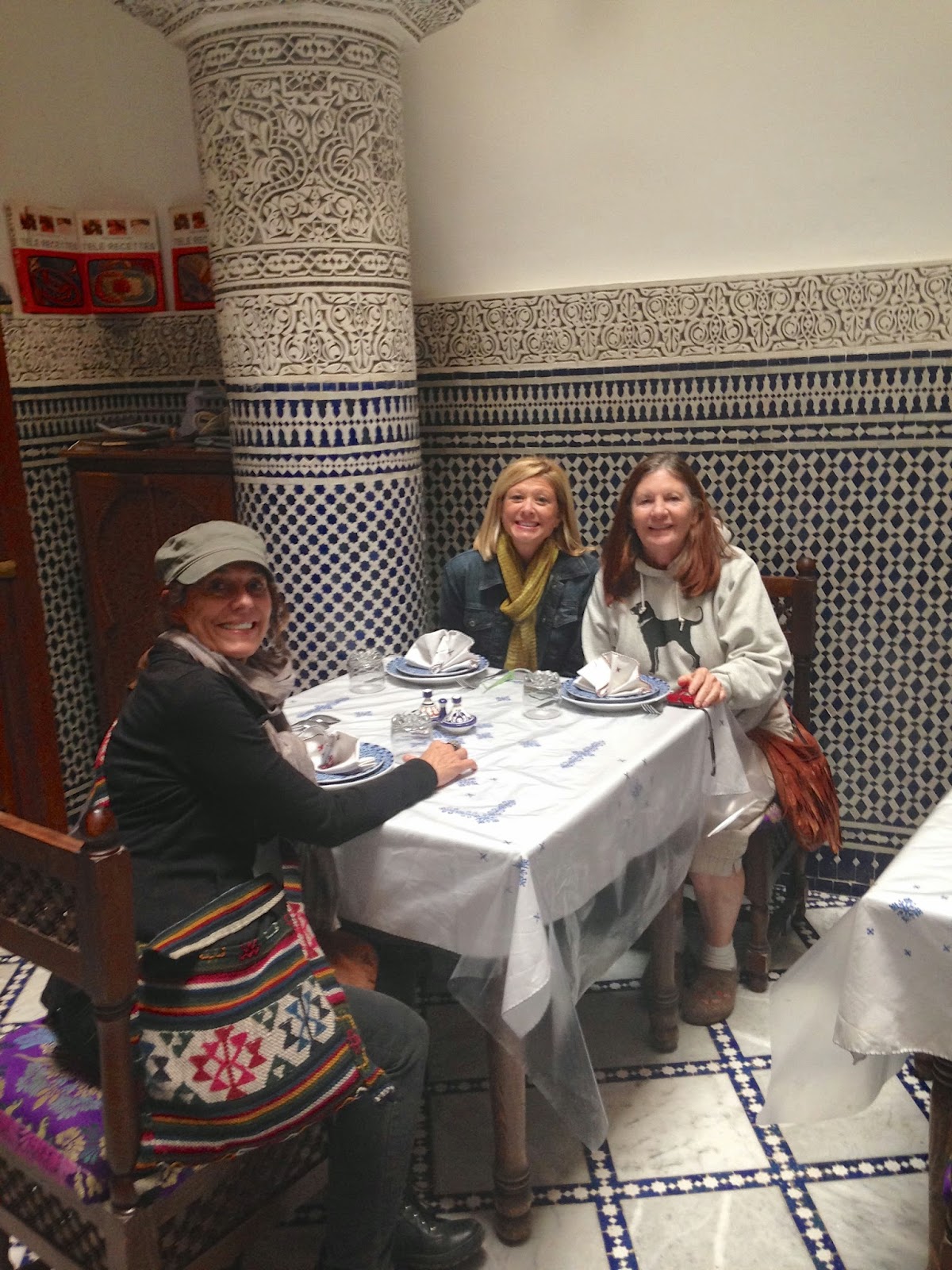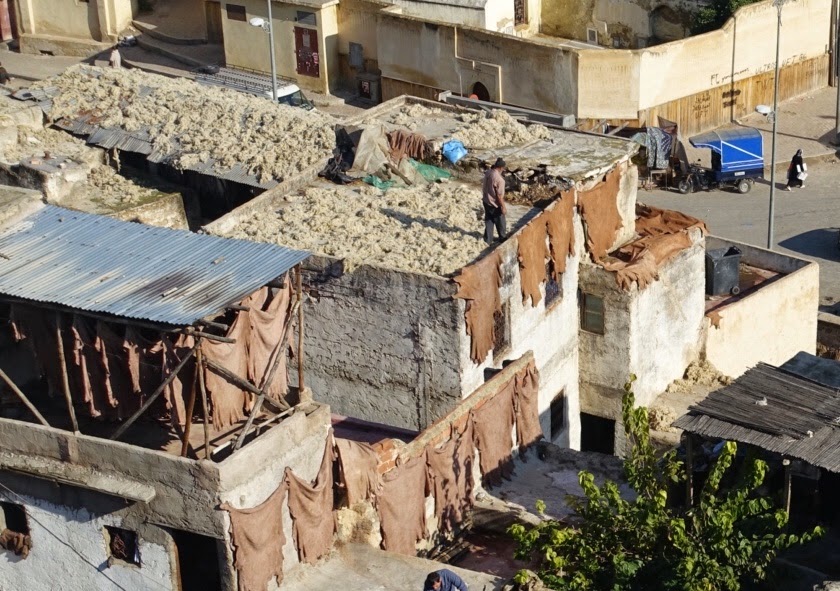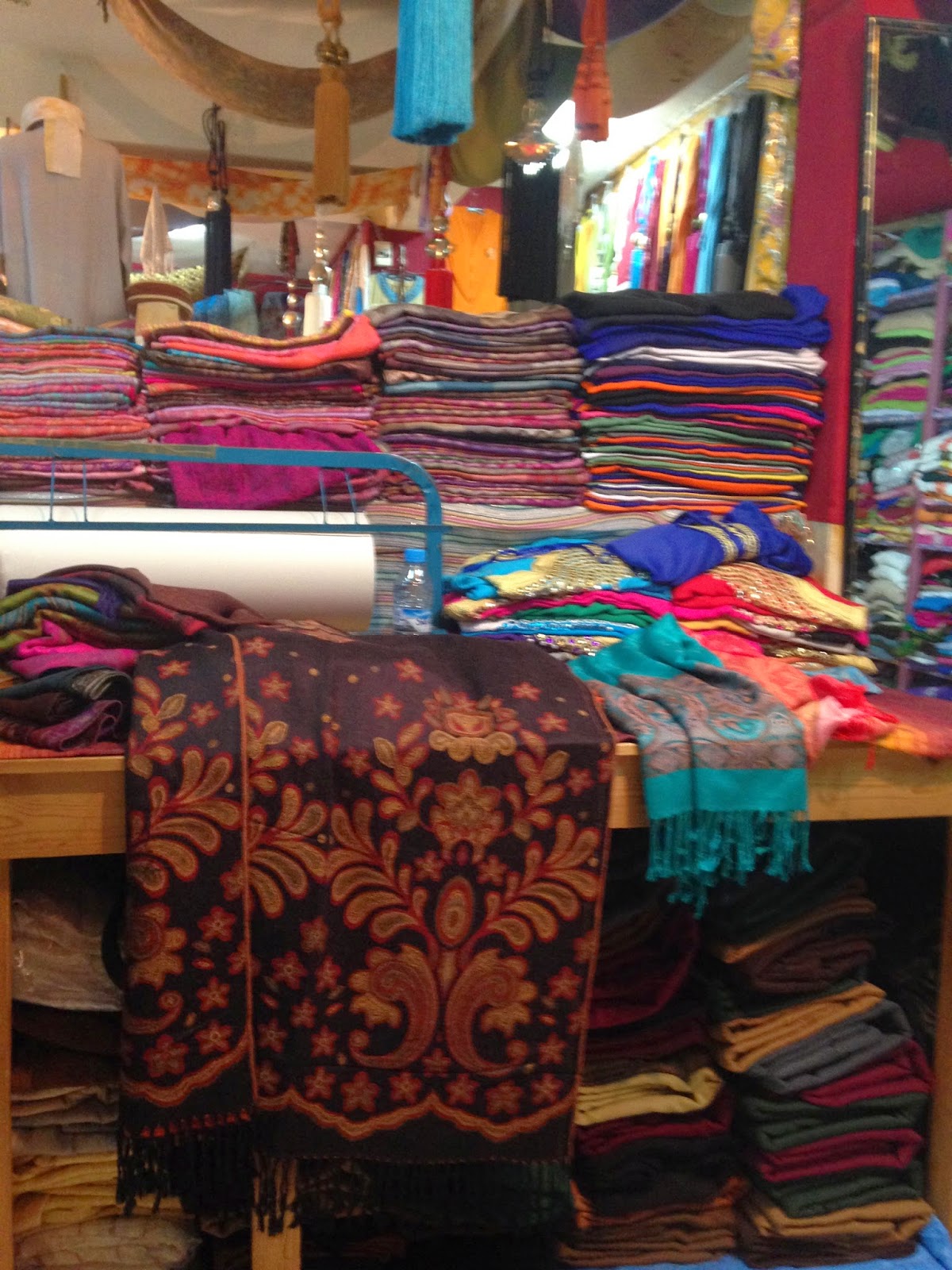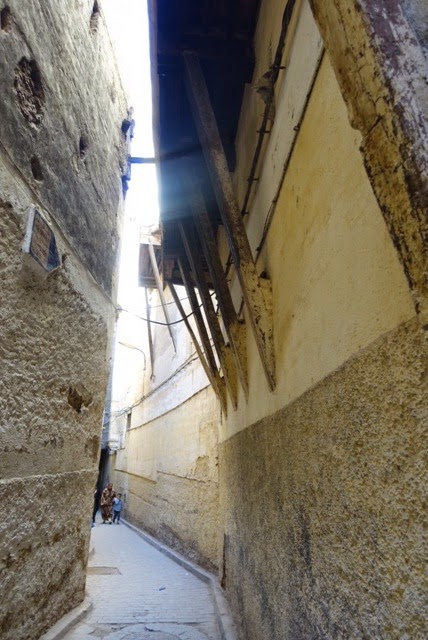| My Moroccan travel buddies…. Dee Dee and Mimi |
Our first stop with Aziz was the Kings palace… that would be his “other” palace, the “main” one being in Rabat. I found out yesterday that “other” means 48…more on that later. It was similar to the palace in Rabat… nothing simple, mosaic for miles and lots of ornate brass. It feels rather disrespectful to say once you’ve seen one Moroccan palace, you’ve seen them all, but I will say it anyway. It felt uncomfortable for me to see such an excessive display of grandeur and wealth in a 3rd world country. Most of the front of the palace is done in zillij tile, or a type of mosaic, which is an old technique used by skilled artisans who hand cut and glaze each and every tile then lay them in intricate geometric patterns. It really is quite impressive, especially when seen in such massive fields.
 |
| The tile is quite impressive, especially when seen in massive fields such as that around and above the door… |
| Every single tile is glazed, cut and laid by hand. |
The bigger interest for us was the medina and the labyrinth of streets and maze of markets or souqs. Once inside the medina, it felt as if we were walking deeper and deeper into a civilization that isn’t seen at all from the outside. There are no cars allowed inside, which became clear as we got deeper and deeper into the bowels of this ancient, walled city, that was built in the early 700’s. The streets seemed to narrow the farther in we went, with some of them so narrow that I couldn’t even stretch my arms out completely while touching both walls. As we zigged and zagged down the narrow pathways, I asked Aziz how anyone would give directions to their house to an outsider? He said that everyone knows where everyone lives inside of the medina and that even though he also lived there, he still gets lost on occasion. I can’t imagine how frightening it would be to be lost in the maze, especially at night, as the only natural light that was coming in was from the narrow openings where the tops of buildings didn’t quite meet. There is electricity, but I’m guessing it’s pretty dark in there at night. Before we went in, Aziz did ask if any of us suffered from claustrophobia. I’m guessing if one of had said yes, we would have turned around and gone back to the King’s palace. This was no place for anyone who suffers from a fear of small places!
 |
| Furnishings that are wider than this narrow road, have to be brought in through the roof. |
Aziz told us that the medina in Fez is the oldest in Morocco and within its walls is the oldest university in the world. Surprisingly, the original plumbing is still in use, which was really hard to wrap my head around. Over 10,000 people live in the medina and their houses all have simple, understated doors that line the narrow streets and pathways. Moroccans believe that large, ornate doors that would portray wealth, are bad luck and it is better to have a modest, very simple door, regardless of what’s behind it. The palaces it would seem are the obvious exception to this belief. Most had small hand knockers on them, one placed at a “normal” height for people walking and the other placed higher for those seated on mules.
Lunch was at a place that Aziz recommended for us, with assurance that we’d really like it after we told him we were growing tired of tagine (a type of Moroccan stew) and was there a restaurant that sold anything else?? Without answering our question, he then added that it was really clean. Our confidence to eat outside of the traditional faded on that one. The menu had 8 different meal options, all with the same salad and dessert and different entree options, well, I say different, but all but one were variations on the tagine theme, and the non-tagine dish was couscous. After almost 3 weeks of having some sort of tagine at least once a day, our stomachs longed for bland, white food. Mashed potatoes and macaroni and cheese with ginger tea to drink would have been nice. My stomach had started giving me the 3rd world nudge the day before so I was exercising caution, not an easy task in this spice loving country. With little enthusiasm, we ate what we could and did a lot of moving food around on the plate to look like we had at least tried.
 |
| Tile for miles… |
| This was our “salad”… a hint of what was to come… and it wasn’t mashed potatoes… |
 |
| The animal skins are soaked in water and pigeon droppings… the droppings are acidic and soften the hides. They are then placed in these large kettles of natural dyes. |
 |
| Hides… hanging everywhere… |
| Moroccan slippers or babouche. A very common footwear in Morocco, even though it seemed more like a slipper to me… |
From leather tanning to weaving… the traditional Berber scarfs are made in part from the silk from inside the agave plant. The weaving, all by hand, was a very interesting process to watch. At this point, however, I realized that our pal Aziz has directed us to “specialty shops” where he shares a bit of the profit of anything sold to us. It would explain why when I stopped to look at one of the smaller “booths” for a scarf, he told me to wait, that he had a place that would give me a much better price. I guess I could have been annoyed, but it’s good business for the guides, who are a necessity, and if they can make a little extra on top of the little bit he was charging us, then why not.? The sales style in Morocco is NOT aggressive. It’s a very comfortable place to shop. Once in a shop, there is a little more salesmanship, especially once the bartering starts (a custom that is as much of a game as much as anything else and one that Moroccans really enjoy, in fact I’m told that prices are doubled so the bartering is a necessary part of the shopping experience). I never once felt like there was any aggression directed towards me to shop in one place or another with shouts of prices and deals, which was very refreshing.
 |
||
| One of the many weaving shops… |
 |
||||
| The sales man was trying hard to sell me a Berber scarf…. I was one step ahead of him. Already have one. Already donned it in the desert. He did have a pretty cool way to tie it though… |
A fun day in Fez…
and that’s what I told my students the next day when they jokingly asked me if I did anything to celebrate Moroccan Independence Day. They didn’t do anything.
 |
| piles and piles of pashminas (or stacks of scarves…) |

